Discover the timeless allure of Costa Brava through its majestic castles, where history and beauty converge.
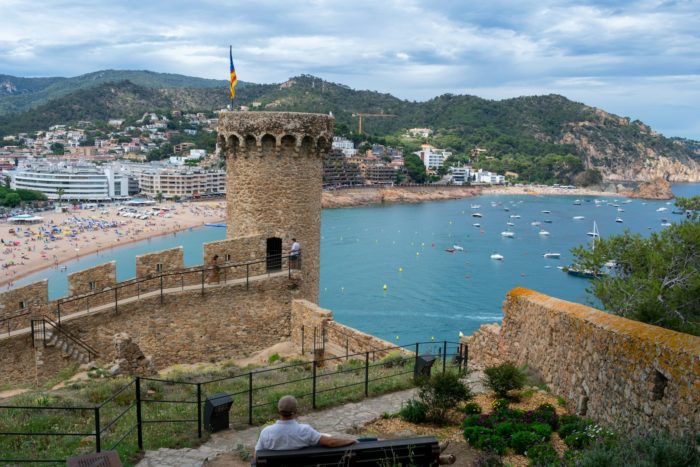
Tossa de Mar: Photo by Mateo Krossler.
Nestled along the rugged shores and lush landscapes of Catalonia, the Costa Brava is a region steeped in history and culture. It’s a land where the old and the new merge seamlessly, and nothing embodies this spirit more than the majestic castles that stand as sentinels to history. These structures, ranging from well-preserved fortresses to romantic ruins, offer a direct link to the past, inviting visitors to step into a bygone era.
For the intrepid traveller, the castles of Costa Brava are more than mere tourist spots; they are portals to the medieval times when knights, lords, and ladies played their part in the grand theatre of history. Each castle has its own story to tell, with walls that whisper tales of sieges and sanctuaries, of power and perseverance. Today, they are easily accessible treasures that beckon explorers to uncover the grandeur and mystery of medieval Catalonia.
Whether you’re a holidaymaker seeking a cultural day out, a homeowner in search of local heritage, or a resident eager to delve deeper into your region’s history, the castles of Costa Brava offer an enriching experience. They are not just stone and mortar; they are chapters of a story that continues to fascinate and inspire.
Let us embark on a journey to discover the most accessible and captivating castles of Costa Brava. These bastions of history are not just relics to be admired but are vibrant cultural hubs that continue to play a significant role in the Costa Brava lifestyle.
The history of castles in the Costa Brava
The Costa Brava, with its picturesque coastline and lush hinterland, has been a coveted territory for millennia. The castles that dot this region are testaments to its turbulent history, where each stone is a chronicle of conquests, wars, and the rise and fall of empires.
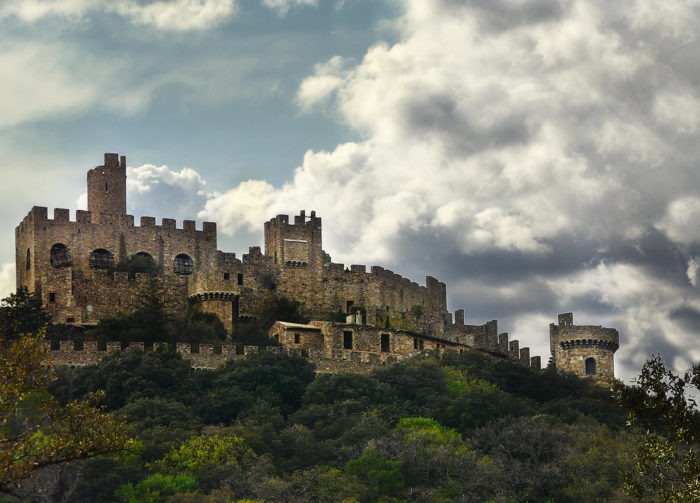
Castell de Requesens: Photo by Ramirez de Gea licensed under CC BY 2.0.
The origins of many Costa Brava castles trace back to the early Middle Ages when the threat of invasion from sea-borne forces necessitated strong defensive structures. These castles served as the military backbone of various ruling powers, from local Catalan lords to the expansive realms of the Aragonese and beyond.
Over the centuries, these formidable structures underwent transformations. What were once stark military installations evolved into opulent residences for the nobility, complete with intricate architectural flourishes. It was during this time that many castles began to foster the surrounding communities, offering protection and contributing to the economic and social development of the region.
The Renaissance and Enlightenment periods saw a decline in the military significance of these castles, with many falling into disrepair. However, the romantic allure of their past glory led to a revival of interest in the 19th and 20th centuries, with restoration efforts seeking to preserve them for future generations.
Today, the castles of Costa Brava stand proudly as symbols of Catalonia’s rich heritage. They are not only historical landmarks but also serve as cultural venues for events, exhibitions, and educational programs. The walls that once echoed with the clash of swords now resonate with the voices of guides and the footsteps of visitors from around the world.
A guide to the most iconic Costa Brava castles
Venturing into the heart of Costa Brava, visitors will find a series of castles that are not only awe-inspiring but also welcoming to those looking to immerse themselves in history.
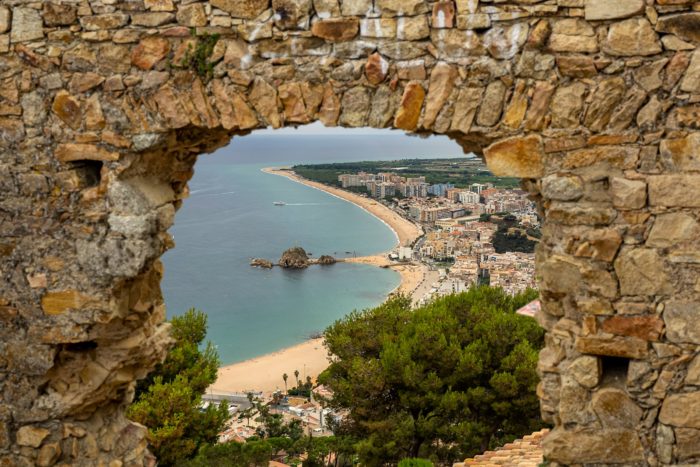
The view from Castell de Sant Joan in Blanes: Photo by Manuel Torres Garcia.
Castell de Tossa de Mar: Perched on the coast, this castle is more accurately a walled-in medieval town, which dates back to the 12th century. It is one of the few fortified medieval towns still standing on the Catalan coast and offers breath-taking views of the sea. With its accessible location, Tossa de Mar is a favourite for visitors, offering a glimpse into the past alongside seaside cafés and shops.
Castell de Sant Joan: Overlooking the town of Blanes, the remains of this castle offer panoramic views over the coast and the botanical gardens below. While much of the original structure has been lost to time, the climb to the top is rewarded with not only vistas but also the sense of connection to the strategic importance this site once held.
Castell de Peralada: Located in the north of Costa Brava, Peralada Castle is an emblem of elegance and culture. Originally dating back to the Middle Ages, this castle has been transformed into a luxurious complex, featuring a casino, a prestigious Perelada winery pivotal in the production of acclaimed DO Empordà and Cava wines, and the host of the renowned Peralada Festival during the summer months. The castle’s beautifully maintained gardens and a library with over 100,000 volumes further establish it as a cultural haven. Guests can delve into the world of winemaking through tours, tasting sessions, and educational insights into the refined wine production process, making Peralada Castle a comprehensive experience of elegance, culture, and viticultural excellence.
Castell de Púbol: This castle gained fame in the 20th century as the residence of the surrealist artist Salvador Dalí and his wife Gala. Nestled in the small village of Púbol, the castle is now a museum that showcases art and memorabilia related to the artist. It’s a fusion of medieval architecture and modern art, set within tranquil gardens.
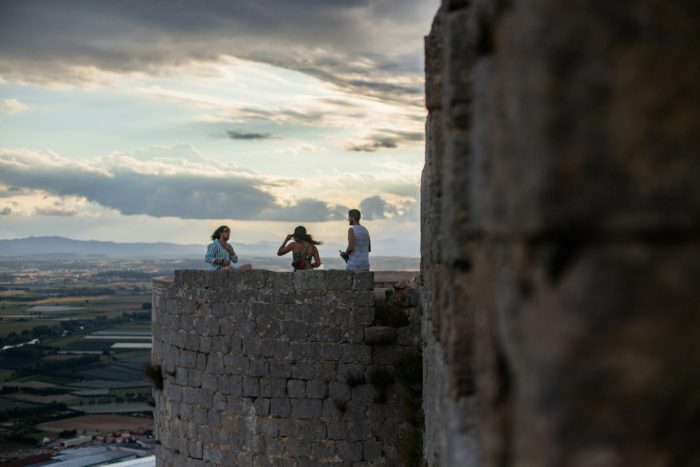
Castell de Montgrí: Photo by David Monje.
Castell de Montgrí: Dominating the skyline of the Montgrí Massif, this unfinished fortress dates back to the 13th century. Though it was never completed, the Castell de Montgrí is an impressive sight with four large towers that can be seen from miles away. Its hilltop position offers some of the most stunning views of the Empordà region, and the hike to the castle is a favourite for outdoor enthusiasts.
Castell de Sant Ferran: Located in Figueres, this is one of the largest fortresses in Europe, built in the 18th century. It’s not a medieval castle but a military fortress with vast underground cisterns, extensive ramparts, and commanding views of the surrounding area. It played a significant role in various historical contexts, including the Napoleonic wars and the Spanish Civil War.
Castell de Requesens: This castle is located near the village of Cantallops, close to the French border, and is nestled within the Albera Natural Park. It’s known for its unique blend of Romanesque and Gothic architectural styles and was extensively renovated in the late 19th century.
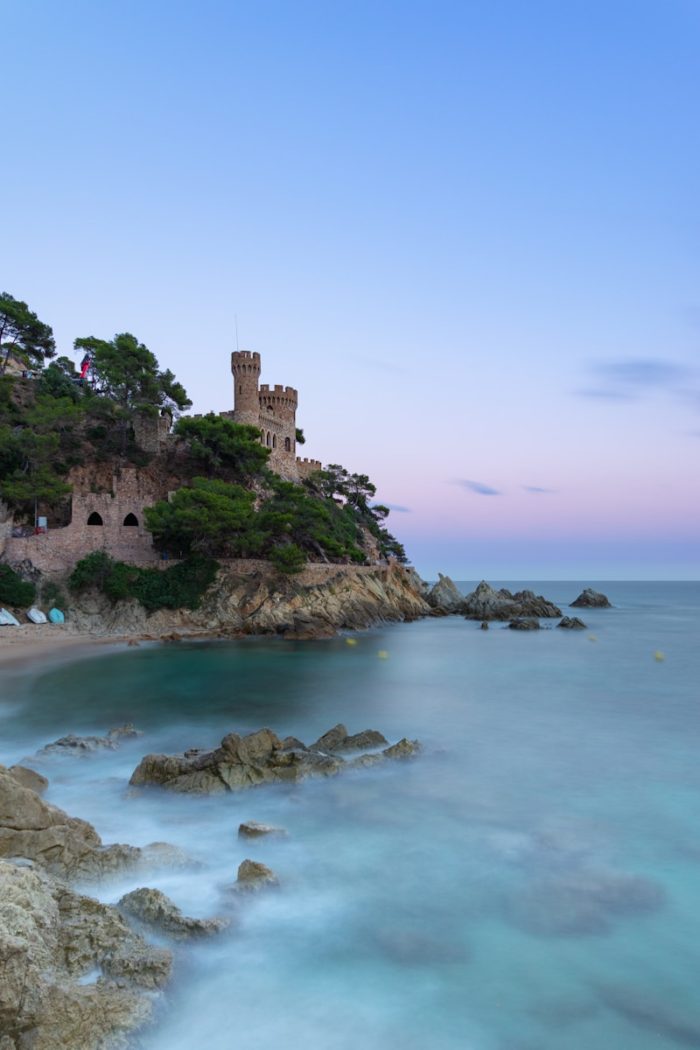
Castell d’en Platja: Photo by Jordi Vich Navarro.
Castell d’en Plaja: Perched at the edge of Lloret de Mar’s main beach, Castell d’en Plaja is a striking feature of the coastal landscape, despite its relatively recent construction in the 20th century. Conceived by Narcís Plaja, the castle evokes the romantic allure of medieval fortifications, serving as a picturesque landmark against the backdrop of the Mediterranean. While it does not share the ancient heritage of Catalonia’s many historical castles, Castell d’en Plaja has become an iconic part of Lloret de Mar’s appeal, attracting visitors with its fairy-tale appearance and scenic location.
Girona city walls: Although Girona does not have a traditional castle within its city limits, it is renowned for its well-preserved medieval city walls. The city’s history is rich with sieges and battles, and its ancient fortifications offer a castle-like exploration experience.
Castell Palau dels Bisbes de Girona: This is not a traditional castle but rather a historic palace that served as the residence of the Bishops of Girona. Located in the heart of the city, this building is part of Girona’s rich historical and architectural heritage, showcasing the religious and cultural significance of the area throughout the centuries.
Castell de Peratallada: Renowned for its stunning preservation, this castle is the centrepiece of one of the most beautiful villages in Spain. The name Peratallada derives from the Catalan for ‘carved stone’, aptly describing the fortifications carved out of the rock bed it stands on. Visitors to the castle can enjoy guided tours that detail its history and significance in regional defence.
Castell d’Aro: Situated inland, this castle remains at the heart of the well-preserved medieval town which takes its name from the castle. It’s a place where visitors can walk the cobblestone streets and experience the ambiance of the Middle Ages. While access to the castle interior is limited, its presence is a pillar of the town’s identity, and the surrounding area is rich with cultural activities and artisanal shops.
Castell de Llagostera: Although much of the original structure is no longer standing, the site holds historical significance and is emblematic of the region’s medieval past.
Ruins
As well as these well preserved examples of castles on the Costa Brava, the ruins of numerous other castles dot the hills in the region. Sometimes when driving you can see the remains of fortifications standing on a lonely hilltop. Below are some of the most accessible Costa Brava castle ruins, but the list is far from exhaustive.
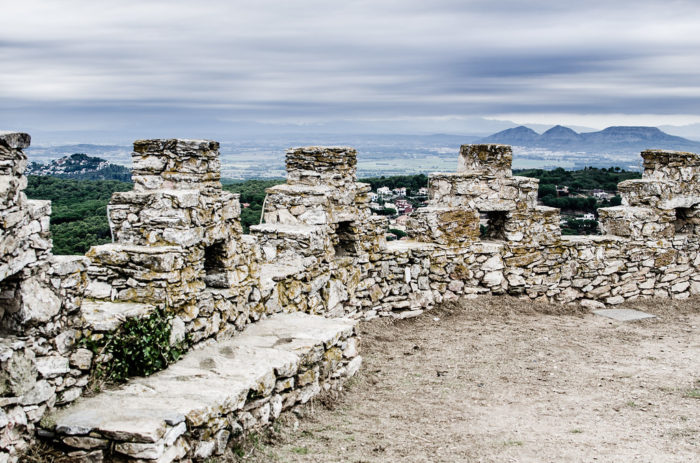
Begur Castle. Photo by Micurs licensed under CC BY-SA 2.0.
Begur Castle: Sitting atop a hill in the town of Begur, this castle offering panoramic views of the coastline and the surrounding area. The ruins of this 11th-century castle are accessible to the public, and its elevated position makes it a popular spot for visitors looking to capture the beauty of Costa Brava. From there you can see for miles in every direction.
Ciutadella de Roses: A true jewel of the Costa Brava, the Ciutadella de Roses is a fortress with a history as layered as the strata of an archaeological dig. The site encompasses a rare blend of remnants from ancient Greek and Roman settlements to a medieval monastery and a Renaissance military fortress. This vast complex provides a comprehensive historical experience, allowing visitors to walk through time—beginning with the early settlers and leading up to the military innovations of the 16th and 17th centuries.
Its strategic location on the Bay of Roses made it a focal point for various cultures and armies, reflecting the region’s importance throughout history. Today, the Ciutadella is not only an essential visit for those looking to understand the region’s past but also serves as a venue for festivals and events, giving it a lively role in contemporary culture. With accessible paths and informative displays, the Ciutadella de Roses is an educational and enjoyable destination for all ages.
Castell de la Trinitat: Guarding the bay of Roses, the Castell de la Trinitat offers a historical voyage with strategic roots in the defence of the Catalan coast. The castle stands on a promontory, providing visitors with spectacular views of the Roses coastline. Its pentagonal structure is a unique example of the military Renaissance architecture in Catalonia, and its proximity to the Cap de Creus Natural Park makes it a perfect spot for those combining historical interest with a love of nature.
Castell de Sant Iscle: The ruins of this castle offer a more intimate glimpse into the region’s history. It’s one of those hidden gems that aficionados of medieval architecture and history might seek out for its tranquillity and the stories it holds.
Castell de Sant Miquel: Not far from Girona, the ruins of Castell de Sant Miquel sit atop a hill offering stunning panoramic views of the area, including the city of Girona and the Pyrenees. The castle dates back to the 11th century and can be reached via a hike, offering visitors not only a glimpse into the past but also an opportunity to enjoy the natural beauty of the surroundings. It’s a favourite for those who love combining history with outdoor activity.
Hotels
If visiting a castle on the Costa Brava isn’t enough then there’s always the option to stay in a hotel located in a converted castle.
Hotel Castell d’Empordà: This is a prime example of a castle converted into a hotel, located near La Bisbal d’Empordà. It combines the charm of a medieval castle with modern luxury, offering guests a unique stay amidst historical walls. The hotel is situated on a hill with picturesque views of the Empordà region, blending history with comfort.
Hotel Sants Metges: Located in the Sant Julià de Ramis area, this hotel is situated within the premises of what used to be a military fortress, part of the Dels Sants Metges complex. The hotel combines modern luxury with historical elements, offering guests a unique stay experience. The renovation respects the original structure while incorporating contemporary design, making it a prime example of how historical sites can be repurposed for modern uses.
Tips and practical information
Visiting the castles of Costa Brava is a delightful experience that requires some forethought to make the most of your time. Here are some tips and essential information to help you plan your castle explorations.
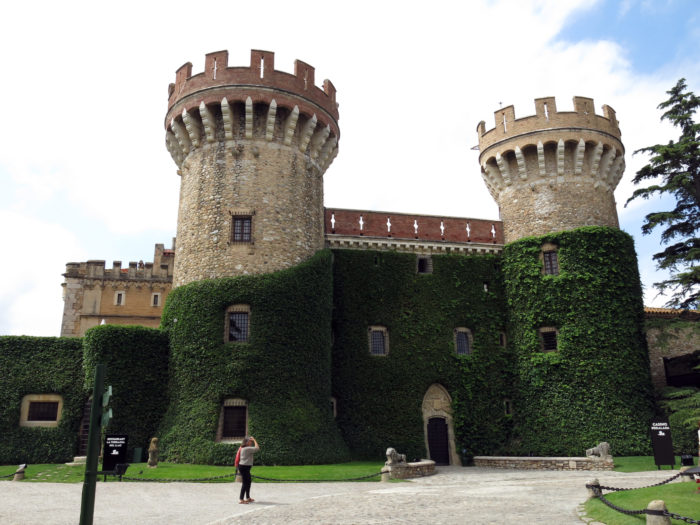
Peralada Castle. Photo by Enfo licensed under CC BY-SA 4.0
Timing your visit
- Many castles have specific opening times, and some may be closed during off-season months. It’s always best to check the latest visiting hours and book tickets in advance if possible, especially for sites like Peralada Castle, which also hosts events and festivals.
- Consider visiting during the week to avoid weekend crowds, ensuring a more serene experience.
Getting there
- Public transportation options are available for some sites, but renting a car provides the most flexibility for visiting multiple castles, especially those that are off the beaten path.
- When planning your route, use GPS or a reliable map, as some castles are located in areas with limited signage.
What to bring
- Comfortable walking shoes are a must, as many castles are situated on elevated ground or require some walking to reach the best viewpoints.
- A camera or smartphone to capture the stunning architecture and breath-taking vistas you’ll encounter.
- Sun protection, including a hat and sunscreen, is essential, especially during the summer months.
Facilities and accessibility
- Check in advance for the availability of facilities like restrooms, cafés, or gift shops, particularly if you’re visiting with family or have specific needs.
- Many castles have made efforts to be more accessible, but given their historical nature, some areas might not be suitable for visitors with limited mobility. Always check ahead for accessibility information.
Guided tours
- To enrich your visit, consider joining a guided tour. Some castles offer tours in English that provide insights into the history and architecture of the site.
- Audio guides are also sometimes available, offering a self-paced way to learn about the castle’s features as you explore.
Respecting the Sites
- Remember that these castles are part of our shared cultural heritage. Follow any guidelines provided for the preservation of the sites, and do not remove any artefacts or disturb the grounds.
Planning your visit with these considerations in mind will ensure a memorable and hassle-free experience as you step back in time and explore the storied castles of Costa Brava.
Events and activities at Costa Brava castles
The castles of Costa Brava are not just static relics of the past; they are vibrant cultural centres that host a variety of events and activities throughout the year. These gatherings range from traditional festivals to modern performances, offering something for every visitor.
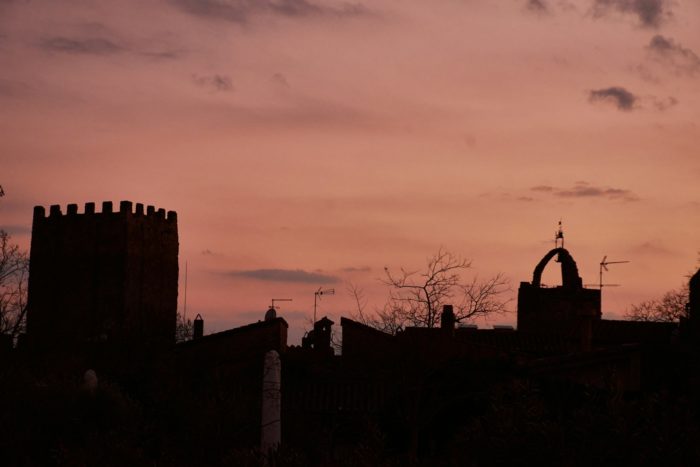
Peratallada at dusk: Photo by Héctor J. Rivas.
Festivals: Some towns, such as the medieval village of Peratallada, celebrate their history with annual medieval festivals with market stalls selling artisanal goods, while Llagostera celebrates its Roman history in the lead up to Easter. The festivals provide a lively way to experience the history of the region first-hand.
Music and performance arts: Peralada Castle, with its renowned summer festival, stands out as a prime venue for opera, classical music, and ballet performances, drawing international artists and audiences. Similarly, the Ciutadella de Roses has been known to serve as a stunning backdrop for concerts and theatre productions, offering entertainment amidst historical grandeur.
Exhibitions and workshops Several castles, including the Castillo de Tossa de Mar and the Castell de Sant Joan, host exhibitions that delve into local history, art, and culture. Workshops and educational programs are also available, ranging from archery and medieval crafts for children to historical lectures and wine tasting sessions for adults.
Guided tours and night visits To explore the castles in a different light, look for special guided tours and night visits. These tours often focus on specific aspects of castle life or historical periods, providing insights not covered during daytime visits. Night visits, especially, offer a unique atmosphere, with some castles lit by torches or featuring theatrical performances that bring history to life.
Outdoor activities The natural surroundings of many castles, such as Castell de Montgrí and Castell de la Trinitat, are perfect for outdoor activities, including hiking, bird watching, and photography. The blend of cultural exploration with the beauty of the Costa Brava landscape makes for an unforgettable experience.
Participating in these events and activities not only enriches your visit but also supports the preservation and cultural vibrancy of these historic sites.
Whether you’re looking to immerse yourself in the medieval past, enjoy world-class performances, or simply explore the natural beauty of the Costa Brava, the region’s castles offer a wealth of opportunities to engage with history and culture.

